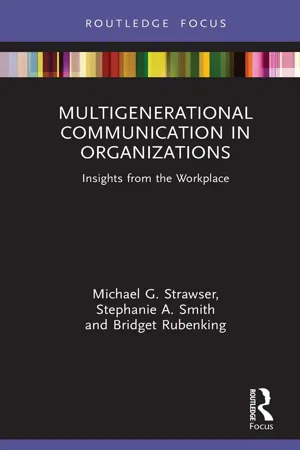
Multigenerational Communication in Organizations
Insights from the Workplace
- 150 pages
- English
- ePUB (mobile friendly)
- Available on iOS & Android
Multigenerational Communication in Organizations
Insights from the Workplace
About this book
Multigenerational Communication in Organizations explores generational differences in the changing workplace from a communication perspective.
Starting from the reality that a workplace can contain up to five different generations, these chapters examine topics like generational perceptions on the job search process; organizational culture; organizational identification; organizational crises; the dark side of workplace communication; remote working; and future challenges. Outlines of best practices and suggestions for application are provided based on the most recent data and corresponding literature. The authors also develop a data-forward understanding of Generation Z in context.
This book is ideal for both scholars and practitioners in organizational communication and management, as well as for workplace managers and supervisors.
Frequently asked questions
- Essential is ideal for learners and professionals who enjoy exploring a wide range of subjects. Access the Essential Library with 800,000+ trusted titles and best-sellers across business, personal growth, and the humanities. Includes unlimited reading time and Standard Read Aloud voice.
- Complete: Perfect for advanced learners and researchers needing full, unrestricted access. Unlock 1.4M+ books across hundreds of subjects, including academic and specialized titles. The Complete Plan also includes advanced features like Premium Read Aloud and Research Assistant.
Please note we cannot support devices running on iOS 13 and Android 7 or earlier. Learn more about using the app.
Information
1 The Evolving Organization
1.1 Investigating Organizational Change
Table of contents
- Cover
- Half Title
- Series Page
- Title Page
- Copyright Page
- Contents
- List of tables
- 1 The Evolving Organization
- 2 A Generational Perspective
- 3 Understanding Generational Communication Differences in the Workplace
- 4 Generational Expectations of the Job Search
- 5 Perspectives on Organizational Culture
- 6 Organizational Identification
- 7 Communication in the Organization: Positive Communication
- 8 The Dark Side of Communication at Work: Conflict and Dissent
- 9 Workplace Satisfaction
- 10 Remote and Virtual Work
- 11 Innovation and Future Challenges
- Index